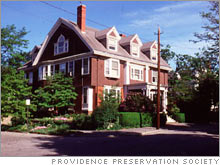|
House tours are all the rage
Historic and architectural tours are becoming crowd favorites - and the real estate industry is eating it up.
NEW YORK (CNNMoney.com) - With interest so high in all things home, no wonder house tours are booming in both number and popularity. These tours, generally run by non-profits focused on historic or neighborhood preservation, allow outsiders an intimate glimpse of the interiors of private homes with architectural or historical significance.
How big are these tours getting to be? The New York Times recently listed more than 40 different house and garden tours in the New York region and surrounding areas alone for the spring, the height of the house tour season. "There's a large audience out there for these kind of events," said Michael Crowe, author of "Deco by the Bay: Art Deco Architecture in the San Francisco Bay Area," who chairs the committee that runs the Oakland Heritage Alliance annual house tours. "It's one of the most popular things we do." The number of people who take the Oakland tour varies each year - usually with the weather, according to Crowe. As many as 2,000 tickets, at $35 to $40 each, have been sold. That's a big payday for the Alliance. It's also a big undertaking. Susan Abele, of the Newton Massachusetts Historic Museum, said its house tour requires months of planning and the services of about 150 volunteers, many of whom are stationed in the houses during tours, providing information and security. Tours also demand the cooperation of homeowners. Christine Lazzaretto, spokeswoman for Pasadena Heritage, in Southern California, which hosts a Craftsman Weekend every October to show off the city's peerless collection of Greene and Greene, Heineman Brothers and other Arts and Crafts-style homes, said: "Some owners don't want to know what their homes look like with all those people tramping through it." She can have trouble finding willing owners. "You have to approach a lot of them to get a few approvals," she said. "Many homeowners are anxious at the start but they tell us later that they have a really good time," said Abele at the Newton museum. "The people who take these tours are very interested and respectful and the owners often spend the whole day answering questions and discussing the house." There's really not much to worry about, according to Crowe. "We've never had a problem with visitors," he said, noting his group has been holding tours for 26 years. Big mix
The number of house tours around the country has grown so large that it's no longer easy to generalize about their scope and nature. Tours may include an eclectic mix of styles, eras and levels of luxury. And they explore inner cities, downtown areas, rich suburbs and gentrifying urban areas. Some have a sharp focus, such as the Frank Lloyd Wright Preservation Trust's annual Wright Plus Benefit House Tour, in Oak Park, Illinois. All the homes open to visitors there were designed by Wright or his contemporaries. This tour sells out every year, according to spokeswoman Lauren Finch, attracting 2,000 Wright aficionados, some of whom come from as far away as the Britain and Australia and pay $85 for a ticket. In contrast, those taking the Boerum Hill tour in Brooklyn, N.Y., see a wider variety of properties. This year homes ranged from a pre-civil war Federal-style to a contemporary renovation. "We try to have a mix of historic and modern," Boerum Hill Association spokeswoman Sue Wolfe said. In nearby Clinton Hill, a wealthy, then poor, now rebounding area, house tours often feature huge 19th century Italianate mansions once owned by oil industry colleagues of John D. Rockefeller to renovated carriage houses to brownstones to modern apartments. It can be a curiously exhilarating mix. Last year, the Providence Preservation Society's 26th annual house tour focused on conversions in the Rhode Island capital's central business district - residences that had been carved out of old office and warehouse buildings. Jack Gold, executive director of PPS, said the tour attracted 1,200 people, and that he's expecting 1,500 to 2,000 for this year's event, which mostly looks at more traditional 19th century houses. Industry aid
Like many tours, the one in Providence gets lots of support from the local real estate industry. Brokers, developers and contractors form a large share of the event's sponsors and many buy ads in the 70-page tour booklet. Contractors like the association because attendees often ask home owners about renovations: Who did their kitchen? Where did they buy their bathroom tile? Many real estate agents act as volunteer docents. They use it as an opportunity to make contacts with people who are obviously interested in houses. Many become clients. In some cases agents even schedule open houses to coincide with house tours. Neighborhood streets stream with visitors and many of them will venture into homes for sale almost like they're part of the tour. It's a natural symbiosis: The real estate industry has a strong incentive to not only help get the word out about the undiscovered charms of some neighborhoods - which the tours are extremely successful in doing. But the everyday efforts of the non-profits that run the tours are directed toward improving and preserving the neighborhoods, which ultimately is good for the real estate agents. If all that sounds too worthy, too "take it, it's good for you," don't worry: The tours are great fun as well.
|
|


